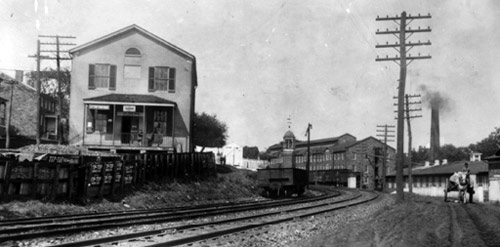
Cotton Mills of the Jones Falls

Woodberry Factory can be seen in the distance, c. 1912. Park Mill is the light-colored building at lower right. (BCLP Collection courtesy of Jaques Kelly, McGrain 609)
Elisha Tyson built a 2-story stone flour mill at this location on the Jones Falls around 1790. It was acquired by Horatio N. Gambrill and his associates, David Carroll, Henry Leef, and William Mason in 1842 and a spinning factory was built on the site, reputed to be the first steam-powered mill in the valley (Buhl 4). Gambrill, Leef and Carroll formed the Mt. Vernon Company and, by 1863, had a total of six mills in the area.
William E. Hooper became a partner in Woodberry Factory — Hooper's first partnership in what was to become a chain of cotton mills — and in 1865 Hooper took over Woodberry Factory and formed the Woodberry Manufacturing Company. Hooper purchased three other mills in the Jones Falls Valley from Gambrill in 1868 (McGrain 609). “Woodberry” became Hooper’s trademark, as well as the name of the neighborhood.
Woodberry Factory was sold with the rest of Wm. Hooper & Sons to the Mount Vernon-Woodberry Cotton Duck Company, a cotton duck trust, in 1899. Woodberry Factory was sold in 1924 to the Frank G. Shenuit Rubber Co., manufacturer of automotive, aviation and industrial tires. Shenuit ceased operation in the 1960s and the building was abandoned (the smokestack still says “Shenuit”) (Black, “Londontown”).
[I've looked around inside a little and there doesn't seem to be much of the original factory left inside the current brick walls. — DN].


